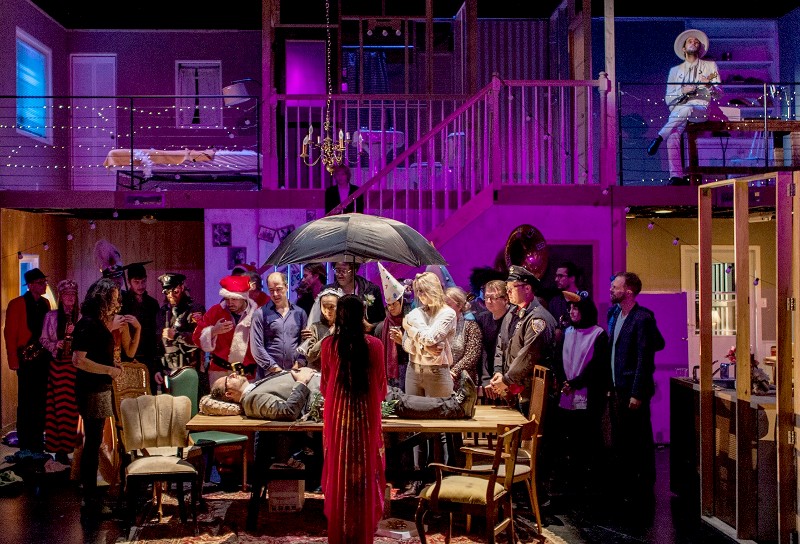Wherever You Are: Geoff Sobelle’s experimental theater piece explores what it means to be "Home"

Among the many, many things that have changed over the last two years is our sense of “home.”
While traditionally associated with comfort and family and love, our homes became claustrophobic prisons of a kind during the pandemic as we holed up to protect ourselves and each other; and though home provided many of us with some semblance of safety, we were nonetheless terrified of being with others and of this dangerous thing that was out in the world that we didn’t yet understand.
So although the UMS presentation of Geoff Sobelle’s Home—a genre-defying hybrid of theater, dance, and interactive performance art that often has the feel of a live silent film—had been originally scheduled for April 2020, seeing it instead this past weekend during its two-day run at the Power Center inevitably meant the audience watched it with COVID-era eyes.
That’s not to say we collectively arrived at the venue with a jaundiced, wary perception filter firmly in place. But for many of us, the abstract idea of “home” as an emotional palette has expanded to include some darker hues, right alongside the more conventionally bright, cozy, warm ones.
Sobelle’s unconventional Home, directed here by Lee Sunday Evans, begins slowly and quietly. Sobelle appears alone, pulls a few connected wood panels out onto the stage, and—on the heels of a quick homage to the classic cinematic image of a house falling down around Buster Keaton—starts meticulously stapling translucent plastic sheets to their edges. This leads to the show’s first moments of theatrical wonder: a lamp on a table and a bed suddenly appear from behind the panels, followed by a door; and as Sobelle hunkers down for rest beneath the sheets, an entirely different person soon emerges from the bed.
A neat trick, to be sure, but just as I wondered if such illusions (designed by Steve Cuiffo) would be the show’s raison d’être, Sobelle and six of his carefully choreographed cast-mates—Sophie Bortolussi, Jennifer Kidwell, Ching Valdes-Aran, Justin Rose, Kaelin Williams Barfield, and Rhyta Musik—became a kind of construction crew, erecting and dressing a two-story house on-stage (Steven Dufala designed the ingenious set); musician Elvis Perkins, meanwhile, dressed in a white suit and hat, haunts Home as an interstitial ghostly troubadour, plucking at an autoharp (or, sometimes, an acoustic guitar) while intoning his wistful, atmospheric lyrics.
Yet once the house is up, the show’s different portrayed moments—calling them “scenes” would seem to imply a narrative, which the show decidedly eschews—are Home’s meat and potatoes. We watch the show’s cast members executing a dance of mundane tasks (choreographed by David Neumann) like getting in and out of the shower (yes, there are brief moments of nudity), brushing teeth, taking out the garbage, cutting up food in the kitchen, gathering items to rush out the door, etc.
Seeing a half dozen actors comedically perform these frenetic actions on top of and around each other suggests that we’re watching a succession of people who have (or will) live in this house, or even representations of a single person’s repeated daily actions over the course of years. The visuals highlight the absurdity of our ant-like toilings, in stark contrast to quieter moments of grief, or one slow-sunrise awakening. These are indeed the ever-changing moods and rhythms of a typical home.
Before long, though, an audience member was invited into “the house,” followed by a couple dozen more, until party lights were being strung up across the theater, with several audience members’ assistance, and the party on stage swiftly changed gears from happy occasion to happy occasion (a baby’s birth, a graduation, a wedding, a birthday, Halloween, Christmas, New Year’s, etc.).
This is, for me, where some residual COVID grief kicked in. Witnessing crowded scenes of unbridled human celebration, adult pillow fights, and even singing a rendition of “Happy birthday” with hundreds of people gave me a vicarious thrill of the “before times” and made me hope for a time when a large cluster of gathered friends equates to nothing but joy, sans the pandemic-era dread and worry.
But every party has its end, of course, and Home concludes with everyone packing things up into moving boxes—a kind of on-stage eviction that feels like a small, not insignificant death. As Perkins appeared again on the darkened stage (lighting design by Christopher Kuhl), with the tacked-back-up, translucent plastic sheeting tossing around in a breeze, the image and sound (designed by Brandon Wolcott) suggested that the vacated, empty house is already haunted—a reminder that everything, even the physical foundation of our daily life on Earth, is but fleeting.
I’ll confess that I worried about how to write this review, because Home, as I’ve mentioned, doesn’t traffic in a cohesive narrative, and it’s so unique that there’s no point of comparison for it. I never knew where Home was taking me next, or what it even was. Performance art? Experiential theater? Yes on both counts?
Whatever it is, it took me on a strange, surprising journey for an evening, and the fact that I got to go on this trip with live people sitting in a theater—well, the pandemic has heightened that for me, too.
For Home isn’t always necessarily a place. Sometimes it’s just someone or something you love that always brings you right back to who you are.
Jenn McKee is a former staff arts reporter for The Ann Arbor News, where she primarily covered theater and film events, and also wrote general features and occasional articles on books and music.


































